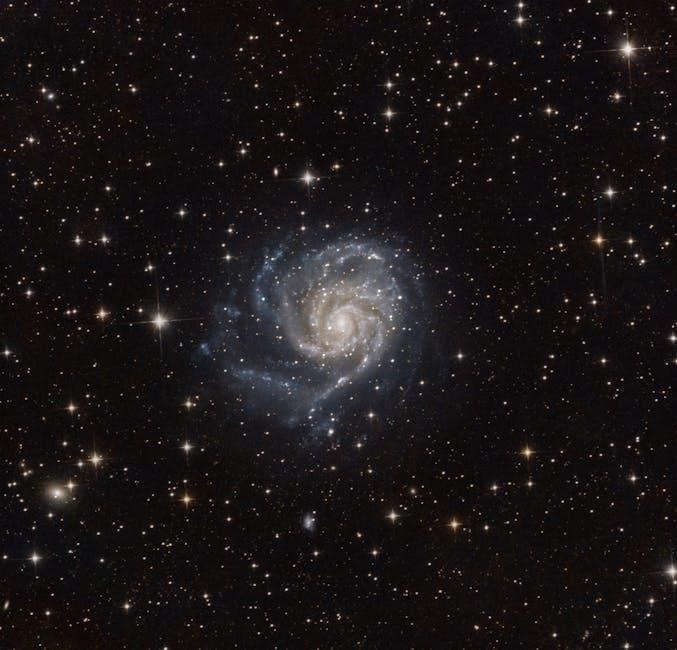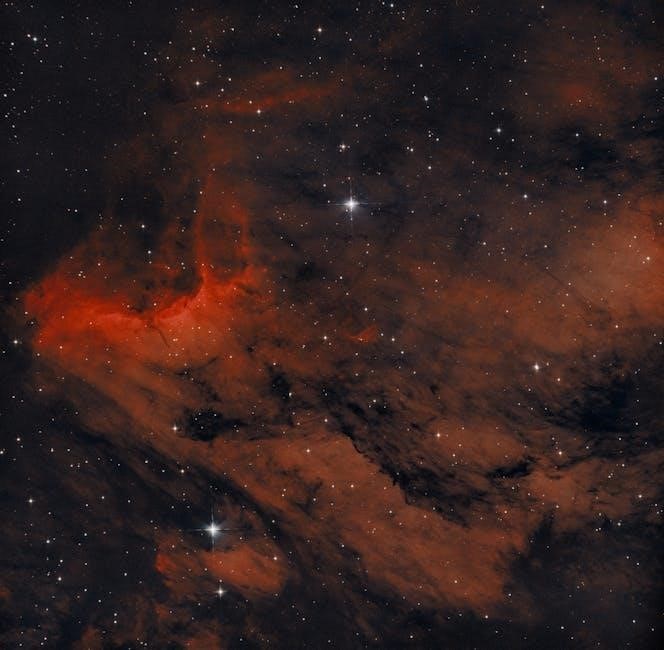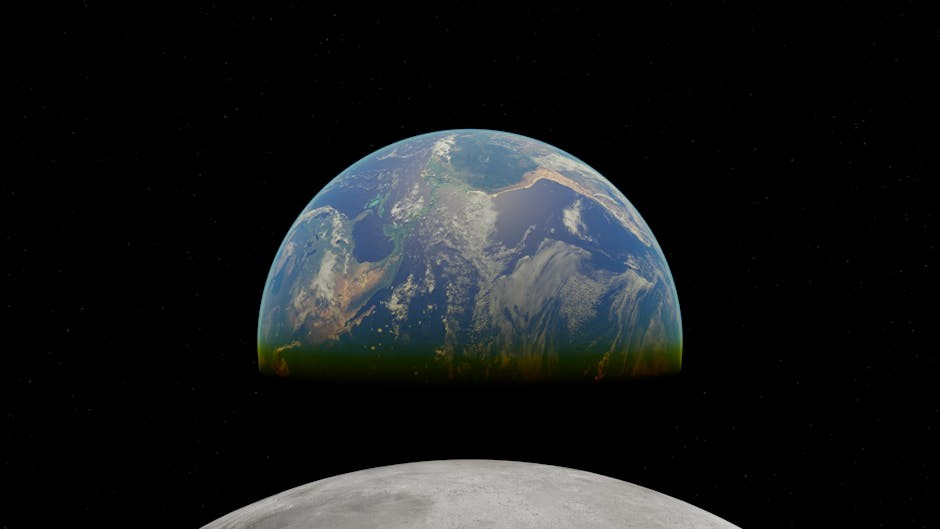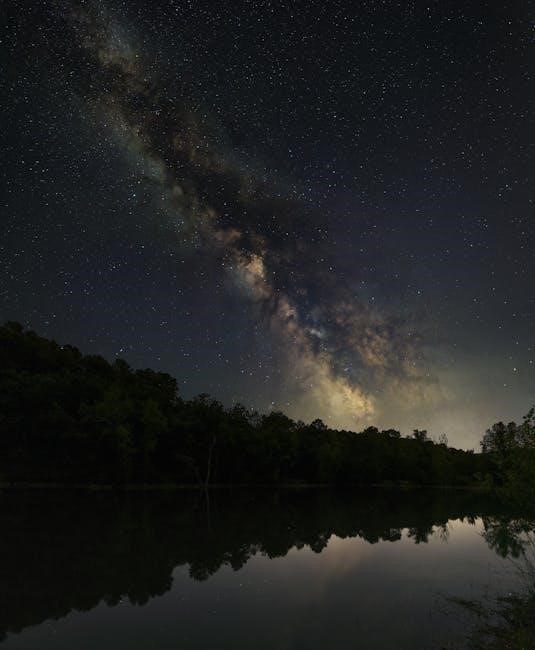The universe is the vast expanse encompassing all matter‚ energy‚ space‚ and time‚ originating from the Big Bang and continuously expanding‚ shaping galaxies and life.
What is the Universe?
The universe is the entirety of all existence‚ encompassing space‚ time‚ matter‚ and energy. It is the vast expanse that contains countless galaxies‚ stars‚ planets‚ and life forms. The universe is believed to have originated from the Big Bang‚ an explosive event approximately 13.8 billion years ago‚ and has been expanding ever since. It is composed of about 70% dark energy‚ 25% dark matter‚ and a small fraction of ordinary matter. The universe operates under physical laws‚ such as gravity and electromagnetism‚ which govern the behavior of its components. Understanding the universe involves exploring its structure‚ evolution‚ and the fundamental forces that shape it‚ making it a subject of fascination for scientists and philosophers alike.
The Basic Structure of the Universe
The universe is structured as a vast‚ interconnected system‚ primarily composed of dark energy‚ dark matter‚ and ordinary matter. Dark energy drives its accelerating expansion‚ while dark matter provides gravitational scaffolding for galaxies and clusters. Ordinary matter forms stars‚ planets‚ and life‚ making up a small fraction of the universe. The large-scale structure includes galaxies grouped into clusters‚ filaments‚ and voids‚ creating a cosmic web. This hierarchical organization reflects the universe’s evolution from the Big Bang‚ with matter clumping under gravity. Understanding this structure reveals how the universe is both homogeneous on large scales and intricately detailed in its components‚ offering insights into its origins and ongoing dynamics.
The Big Bang Theory
The Big Bang Theory is the prevailing cosmological model explaining the universe’s origin. It suggests the universe began as a singularity‚ an infinitely hot and dense point‚ around 13.8 billion years ago. This singularity rapidly expanded‚ cooling and forming subatomic particles‚ then protons‚ neutrons‚ and atoms. Over time‚ gravity condensed matter into galaxies‚ stars‚ and planets. The cosmic microwave background radiation and the abundance of light elements like hydrogen and helium support this theory. The universe continues to expand‚ with this expansion observed in the redshift of galaxies. The Big Bang Theory provides the foundation for understanding the universe’s evolution‚ from its initial explosion to the complex structures we observe today‚ making it a cornerstone of modern cosmology and our understanding of existence.

The Building Blocks of the Universe
The universe’s building blocks include matter‚ energy‚ and the fundamental forces‚ which interact to form atoms‚ particles‚ and larger structures‚ shaping space and time into galaxies and stars.
Space and Time
Space and time are the fundamental components of the universe‚ forming the fabric that connects all physical phenomena. Space refers to the three-dimensional expanse where objects exist‚ while time measures the sequence of events. Together‚ they create spacetime‚ a single‚ unified entity. The theory of relativity describes spacetime as flexible‚ influenced by gravity and motion. Massive objects‚ like stars and black holes‚ warp spacetime‚ affecting the behavior of light and matter. The cosmic microwave background radiation provides evidence of the universe’s origins‚ showing the earliest moments of space and time. Understanding space and time is crucial for exploring the universe’s structure‚ from galaxies to quantum scales‚ and humanity’s place within this vast‚ ever-expanding cosmos.
Matter and Energy
Matter and energy are the foundational elements of the universe‚ with matter comprising all physical substances and energy representing the capacity to cause change. The relationship between them is defined by Einstein’s equation‚ E=mc²‚ where mass and energy are interchangeable. The universe contains various forms of matter‚ including ordinary matter‚ dark matter‚ and antimatter‚ each playing distinct roles. Energy exists in forms like kinetic‚ potential‚ thermal‚ and electromagnetic‚ driving processes from atomic interactions to cosmic expansion. The interplay between matter and energy governs phenomena such as nuclear reactions‚ gravitational forces‚ and the formation of stars and galaxies. Understanding this relationship is essential for unraveling the universe’s structure and evolution‚ from the Big Bang to the present day.
The Four Fundamental Forces
The four fundamental forces—gravity‚ electromagnetism‚ the weak nuclear force‚ and the strong nuclear force—are the cornerstone of the universe‚ governing all interactions. Gravity‚ the weakest but most pervasive‚ shapes cosmic structures and holds galaxies together. Electromagnetism acts between charged particles‚ enabling light‚ heat‚ and chemical bonds. The strong nuclear force binds protons and neutrons‚ forming atomic nuclei‚ while the weak force facilitates radioactive decay and particle interactions. These forces vary in strength and range‚ from the infinite reach of gravity to the short-range nuclear forces. Together‚ they orchestrate the behavior of matter and energy‚ creating the intricate web of interactions that define the universe’s structure and evolution‚ from the smallest subatomic particles to the vast expanse of cosmic phenomena.

Constructing the Universe: The Formation Process
The universe’s formation began with the Big Bang‚ expanding rapidly‚ forming matter‚ and evolving into complex galaxies‚ stars‚ and planets through cosmic processes driven by dark matter and energy.

The Cosmic Timeline
The cosmic timeline traces the universe’s evolution from the Big Bang to the present. It begins with the Big Bang (~13.8 billion years ago)‚ an explosive event initiating space‚ time‚ and matter. The first fraction of a second saw the universe expand rapidly during inflation‚ smoothing out irregularities. As it cooled‚ fundamental particles formed‚ eventually coalescing into atoms‚ primarily hydrogen and helium. Gravity drove the formation of the first stars and galaxies‚ igniting nuclear fusion and lighting up the cosmos. Over billions of years‚ galaxies collided and merged‚ creating complex structures. The timeline also highlights the role of dark matter in shaping cosmic structures and dark energy in accelerating expansion. This chronological journey underscores the universe’s transformation from simplicity to complexity‚ governed by physical laws and mysterious forces.
The Role of Dark Matter and Dark Energy
Dark matter and dark energy are two mysterious components shaping the universe’s structure and evolution. Dark matter‚ an invisible substance‚ accounts for 27% of the universe’s mass-energy‚ providing gravitational scaffolding for galaxies and clusters. It doesn’t emit light but its presence is inferred through gravitational effects. Dark energy‚ comprising 68%‚ drives the universe’s accelerating expansion‚ countering gravity’s pull. Together‚ they dominate the cosmos‚ with ordinary matter forming only 5%. Their roles are critical: dark matter clusters matter‚ while dark energy pushes it apart. Despite their elusive nature‚ their effects are evident in cosmic observations‚ from galaxy rotations to the universe’s rapid expansion‚ making them indispensable to understanding cosmic dynamics and the universe’s ultimate fate.
The Formation of Galaxies‚ Stars‚ and Planets
The formation of galaxies‚ stars‚ and planets is a complex process driven by gravity and cosmic dynamics. Galaxies form from gravitational collapse of gas and dust within dark matter halos‚ creating spiral or elliptical structures. Stars emerge when dense regions of interstellar clouds collapse under gravity‚ igniting nuclear fusion in their cores. Planets form from leftover material orbiting young stars‚ either through accretion of rocky debris or gravitational capture of gas. Rocky planets like Earth form closer to stars‚ while gas giants develop farther out. Over billions of years‚ these processes yield diverse celestial bodies‚ shaping the universe’s structure and enabling life to emerge under the right conditions.

The Universe’s Structure
The universe is a vast‚ expanding cosmic web of galaxies‚ stars‚ planets‚ and dark matter‚ structured hierarchically with filaments‚ voids‚ and clusters‚ governed by gravity and energy.
Understanding Black Holes
Black holes are regions in space where gravity is so intense that not even light can escape. They form when massive stars collapse‚ creating singularities with infinite density. The event horizon marks the boundary beyond which nothing‚ including light‚ can escape. Black holes come in various sizes‚ from small‚ stellar-mass ones formed from star collapses to supermassive ones found at the centers of galaxies. Their strong gravitational pull warps spacetime around them‚ influencing nearby stars and planets. Despite their mysterious nature‚ black holes play a crucial role in the universe’s structure‚ often driving the formation of galaxies and star systems.
The Cosmic Microwave Background Radiation
The Cosmic Microwave Background Radiation (CMB) is the oldest light in the universe‚ dating back to 380‚000 years after the Big Bang. This radiation is the residual heat from the early universe‚ composed of photons that fill the cosmos uniformly. Discovered in 1964 by Arno Penzias and Robert Wilson‚ the CMB confirmed the Big Bang theory‚ providing direct evidence of the universe’s origins. Its near-uniform temperature‚ with tiny fluctuations‚ revealed the seeds of galaxy formation. These fluctuations in density led to the gravitational collapse of matter‚ forming stars and galaxies. The CMB is a cornerstone of cosmology‚ offering insights into the universe’s composition and evolution‚ making it a vital tool for understanding the cosmos.
The Large-Scale Structure of the Universe
The universe’s large-scale structure reveals a complex web-like pattern‚ with galaxies and galaxy clusters forming filaments and walls‚ separated by vast voids. This cosmic architecture emerged from tiny density fluctuations in the early universe‚ amplified by gravity. Dark matter played a crucial role‚ providing the gravitational framework for normal matter to clump together. Galaxies are not randomly distributed but are organized into superclusters‚ with filaments stretching millions of light-years. Voids‚ nearly empty regions‚ occupy the spaces between these structures. This large-scale organization reflects the universe’s evolution‚ shaped by gravitational forces and the influence of dark energy. Understanding this structure helps us map the cosmos and trace its history from the Big Bang to the present day.

The Forces and Interactions
The universe operates through four fundamental forces: gravity‚ electromagnetism‚ and the strong and weak nuclear forces‚ shaping interactions from cosmic scales to atomic levels.
Gravity: The Fundamental Force
Gravity is the most familiar and pervasive force in the universe‚ governing the attraction between masses. Discovered by Newton and redefined by Einstein‚ gravity warps spacetime‚ influencing planetary orbits and cosmic structures; It is universal‚ acting across vast distances‚ and is essential for binding galaxies‚ stars‚ and planets. Unlike other forces‚ gravity is always attractive and plays a central role in forming the large-scale structure of the universe. Its weakness compared to other forces belies its dominance in astronomical phenomena‚ from the fall of an apple to the collapse of stars into black holes. Understanding gravity is key to exploring spacetime and the universe’s evolution.
Electromagnetism and Its Role
Electromagnetism is a fundamental force combining electricity and magnetism‚ mediated by photons. It governs interactions between charged particles‚ shaping atomic structures and enabling light. Essential for matter’s stability‚ it binds electrons to nuclei‚ forming atoms and molecules. The electromagnetic spectrum‚ from radio waves to gamma rays‚ facilitates communication and cosmic observations. Maxwell’s equations unify these phenomena‚ underpinning modern technology like electricity and telecommunications. While weaker than nuclear forces‚ electromagnetism’s range and versatility make it crucial for chemical bonds‚ energy transfer‚ and the universe’s functionality. Its balance with gravity and nuclear forces fosters life and cosmic order‚ illustrating its indispensable role in the universe’s structure and evolution.
The Strong and Weak Nuclear Forces
The strong nuclear force is the most powerful force in nature‚ binding protons and neutrons within atomic nuclei‚ overcoming repulsive electric charges. It acts over extremely short distances and is responsible for nuclear stability and energy production in stars. The weak nuclear force‚ in contrast‚ governs radioactive decay‚ enabling atoms to transmute by altering quark flavors. Both forces are fundamental to the universe’s structure: the strong force holds matter together‚ while the weak force facilitates transformations essential for cosmic processes. Their balance is crucial for nuclear reactions and the formation of elements‚ making them indispensable in the universe’s evolution and energy production.

Humans and the Universe
Humans explore the universe through telescopes‚ space missions‚ and theoretical physics‚ seeking to understand our cosmic origins‚ purpose‚ and potential for life beyond Earth.

Observing the Universe: Telescopes and Space Exploration
Telescopes and space exploration have revolutionized our understanding of the universe‚ enabling humans to study distant stars‚ galaxies‚ and cosmic phenomena. From Earth-based telescopes to space-based observatories like the Hubble Space Telescope‚ these tools capture stunning imagery and data‚ revealing the universe’s vastness and complexity. Space missions‚ such as those to the Moon and Mars‚ have expanded our knowledge of celestial bodies and their potential for supporting life. By combining advanced technology with human curiosity‚ these efforts continue to uncover the mysteries of the cosmos‚ inspiring future generations to explore and discover.
The Search for Extraterrestrial Life
The search for extraterrestrial life is a fascinating endeavor that explores the possibility of life beyond Earth. Scientists use advanced methods like radio telescopes to detect signals from distant civilizations and space missions to analyze planets for biosignatures. Programs such as SETI (Search for Extraterrestrial Intelligence) and missions like the Mars Perseverance Rover exemplify humanity’s quest to find life elsewhere. Discoveries of exoplanets in habitable zones and studies of extremophiles on Earth further fuel this exploration. While no conclusive evidence of alien life exists‚ the search itself expands our understanding of the universe and raises profound questions about our cosmic existence.
Understanding Our Place in the Universe
Understanding our place in the universe involves recognizing Earth’s position within the cosmic landscape. Our planet is one of eight in the Solar System‚ orbiting a star called the Sun‚ which is part of the Milky Way galaxy. The Milky Way is just one of billions of galaxies in the observable universe. Humanity’s existence is a tiny yet significant part of this vastness. By studying the universe‚ we gain insights into its origins‚ structure‚ and evolution‚ fostering a deeper appreciation for our cosmic home. This understanding also inspires curiosity and drives exploration‚ helping us realize the potential for life beyond Earth and our responsibility to preserve it for future generations.

The universe’s construction reveals its intricate complexity‚ from the Big Bang to cosmic expansion‚ highlighting the interplay of matter‚ energy‚ and space‚ sparking endless curiosity.
Summarizing the Construction of the Universe
The universe’s construction began with the Big Bang‚ initiating expansion and the formation of subatomic particles. As it cooled‚ atoms‚ stars‚ and galaxies emerged. Dark matter and dark energy played crucial roles in shaping cosmic structures. Over billions of years‚ gravity condensed matter into celestial bodies‚ leading to planets and life. The universe continues to expand‚ with ongoing star formation and evolution. This journey from a singularity to vast complexity highlights the universe’s dynamic and intricate development‚ governed by physical laws and forces.
The Future of Universe Exploration
The future of universe exploration is poised for groundbreaking discoveries‚ driven by advanced technologies and collaborative efforts. Next-generation telescopes‚ such as the James Webb Space Telescope and the Square Kilometre Array‚ will unveil deeper cosmic secrets. Space missions like the Europa Clipper and Mars Sample Return aim to explore distant worlds for signs of life. Additionally‚ private space companies are pushing the boundaries of accessible space travel. Computational models and AI will enhance our understanding of dark matter and dark energy. International collaborations‚ such as the European Space Agency’s Ariane 6 and NASA’s Artemis program‚ highlight humanity’s shared quest to explore and comprehend the vastness of the cosmos‚ inspiring future generations to pursue astronomical wonders.

Further Reading and Resources
Explore recommended books‚ online courses‚ and documentaries for deeper insights. Join forums and communities to discuss cosmic discoveries and theories‚ enhancing your understanding of the universe.
Recommended Books and Articles
For a deeper understanding‚ start with books like A Brief History of Time by Stephen Hawking‚ which simplifies complex concepts. The Cosmos by Carl Sagan offers a poetic yet scientific exploration. For modern insights‚ The Big Picture by Sean Carroll and Astrophysics for People in a Hurry by Neil deGrasse Tyson are excellent choices. These books provide foundational knowledge and fresh perspectives. Additionally‚ explore articles from reputable sources like Scientific American and Physics Today‚ which often feature accessible explanations of cosmic phenomena. These resources will guide you through the universe’s mysteries‚ from its origins to its intricate structures‚ making them essential for any beginner’s journey.
Online Courses and Documentaries
on Coursera and The Universe on edX for structured learning. Documentaries such as Cosmos: A Spacetime Odyssey and The Universe series offer visually compelling insights. Platforms like MasterClass feature experts discussing cosmic topics. YouTube channels like Crash Course Astronomy provide engaging‚ bite-sized lessons. These resources blend education with entertainment‚ making complex concepts accessible. They are ideal for beginners seeking a comprehensive understanding of the universe’s structure and evolution. Utilize these tools to deepen your knowledge and spark curiosity about the cosmos.
Communities and Forums for Discussion
Engage with online communities like Reddit’s r/Astronomy and r/Physics for discussions on cosmic phenomena. Forums such as Quora and Physics Stack Exchange offer expert insights and answers to complex questions. Social media groups‚ like Astronomy Forum on Facebook‚ connect enthusiasts globally. Additionally‚ platforms like Meetup host local astronomy events. Joining these spaces fosters learning‚ collaboration‚ and networking with others passionate about understanding the universe. Participating in these communities can deepen your knowledge and inspire further exploration of cosmic phenomena.


